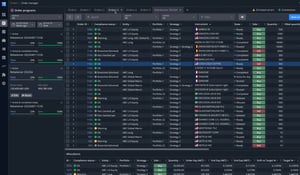
Complete Guide to Portfolio Order Management Systems
A Portfolio Order Management System (POMS) combines the functionality of Portfolio Management Software (PMS) and Order Management Systems (OMS). The combination creates a comprehensive solution for workflows in the Front Office.
This article explores the evolution of POMSs, their key features, and how they stack up against standalone PMS and OMS. You'll also discover the importance of integrations and how automation can benefit your workflow.
If you prefer to watch instead of reading, our founder and CEO, Kristoffer Fürst, walk you through everything you need to know in the video below (if you prefer to read, scroll past the video).
The Evolution of Portfolio Order Management Systems
Vendors initially developed Portfolio Management Systems (PMS) to support portfolio modelling and decision support needs. Portfolio managers relied on PMSs to conduct what-if analyses and simulate portfolio changes, including cash ladder checks.
Order Management Systems (OMSs), on the other hand, were created to aggregate orders, route them for execution, and check pre-trade compliance.
| PMS Capabilities | OMS Capabilities |
| What-if Analysis | Order Creation & Rebalancing |
| Portfolio Modelling | Order Routing |
| Real-time Portfolio Tracking (limited cash views) |
Compliance Checks |
Today, there is a clear trend towards adopting broader, more integrated systems encompassing multiple functional areas. This shift has made standalone PMS less common as asset managers seek solutions to streamline their workflow.
The Rise of POMS: Combining PMS and OMS
The emergence of Portfolio Order Management Software represents a significant milestone in the evolution of investment technology. By combining the functionality of Portfolio and Order Management, a POMS eliminates the need for manual data transfer between systems. Such a combined system reduces errors and improves efficiency.
Comparative Analysis: POMS vs Standalone PMS and OMS
In reality, standalone Portfolio Management Systems (PMS) and Order Management Systems (OMS) will overlap in functionality. Let's look at the most common functional coverage:
The Advantages of a Unified Solution
From this simple table, many advantages of adopting a POMS are immediately apparent. A POMS simplifies the portfolio planning and order-raising process by consolidating PMS and OMS functionality. This integration allows pre-trade compliance to become part of the PMS workflow, reducing manual effort and minimising errors.
An even broader solution than a POMS is Investment Management Software (IMS), which covers front and middle-office workflows. An IMS provides a holistic view of your investment process and enables better decision-making because data processed by the middle office is immediately available for the front office to see.

The Limitations of Standalone Systems
- Inefficient Data Flows: When using separate systems for portfolio and order management, data must be (manually) transferred between them. This can lead to errors, delays, and inconsistencies in your investment process.
- Fragmented Workflow: Without a consolidated system, your investment team may struggle to collaborate effectively. This can result in missed opportunities and suboptimal decision-making.
By opting for a POMS, you can overcome these limitations and enjoy a more efficient, integrated approach to portfolio management. However, evaluating your specific needs and choosing a solution that aligns with your investment strategy and goals is essential.
Bonus: What distinguishes an Execution Management System (EMS) from an OMS?
The OMS, also called a Trade Order Management System, oversees the lifecycle of trades, from creation through compliance and downstream for affirmation and, eventually, settlement.
On the other hand, an EMS focuses specifically on assisting traders with executing orders in the markets.
The meanings of these terms might differ between the buy-side and the sell-side. This article focuses explicitly on the buy side.
Integrations to/from Portfolio Order Management Software
Since a POMS doesn't cover all functional areas of an asset manager, it needs to be connected to upstream and downstream systems, such as:
- Risk Management Software
- Accounting Software
Such integrations can come in different shapes:
- Managed by the vendor, or
- Left for you to figure out, or
- A hybrid in between.
Of course, with an end-to-end IMS, the challenge of these integrations is removed since that single vendor delivers all functional areas.
How you can benefit from automation
Automation is a game-changer in the world of portfolio order management systems. By leveraging the power of automation, you can streamline your investment process, reduce errors, and make more informed decisions. Here's how:
Faster and More Accurate Portfolio Construction
Constructing portfolios and analysing "what-if" scenarios can be time-consuming and prone to human error. However, with automation in your POMS, you can:
- Speed up the portfolio construction process
- Minimise the risk of manual errors
- Explore a wider range of scenarios in less time
This enables you to make better-informed investment decisions and adapt quickly to changing market conditions.

Comprehensive Audit Trail
Some POMS will automatically create a comprehensive audit trail of all actions. The benefits for you are:
| Benefit | Description |
| Transparency | Clear visibility into the decision-making process |
| Accountability | Ability to trace outcomes back to specific trades and assumptions |
| Compliance | Evidence of adherence to regulatory requirements and investment guidelines |
With a robust audit trail, you can demonstrate the integrity of your investment process and protect your firm from potential legal or regulatory issues.
Scalability and Flexibility
As your assets under management grow and your investment strategies evolve, automation allows you to scale and adapt with ease. Automated systems can handle a growing number of portfolios and positions, without you having to scale your team.
Such scalability ensures that your POMS can grow with your business, enabling you to seize new opportunities and confidently navigate complex market environments.
Conclusion
In conclusion, Portfolio Order Management Systems have changed how asset managers handle their investment processes. By combining the functionalities of PMS and OMS, the POMSs offer a comprehensive solution that streamlines workflows and enhances decision-making.









